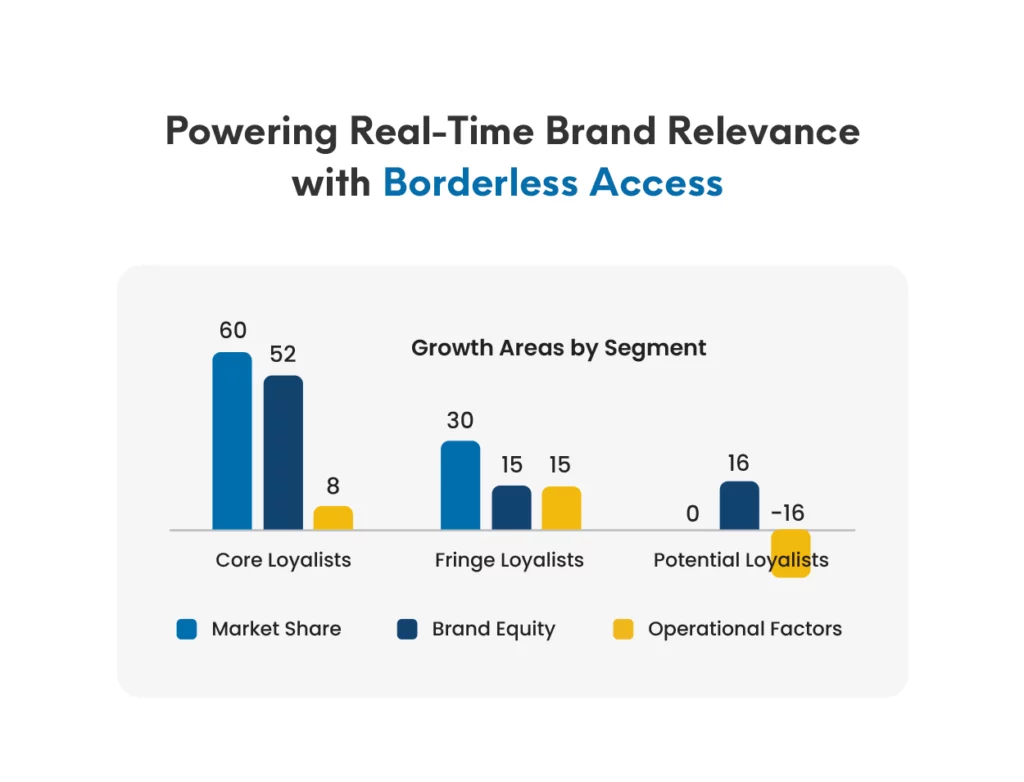Consumer behaviors today shift dynamically, if not monthly, driven by short-form video trends, real-time consumer reactions, and algorithm-driven content suggestions. A single social medial backlash, influencer posts, or viral moments can completely change a brand’s perception.
For CXOs of brands worldwide, this means more than monitoring change; it means actively managing brand relevance in real time. That’s precisely why brand tracking research is no longer optional – it’s essential. But at a point in time when brands are expected to stay on top of shifting consumer behavior and loyalty, static brand tracking systems won’t be enough anymore.
Real-time brand intelligence is the key to maintaining a strong brand relevance today. It means tapping into continuous data signals that reflect how people truly feel, think, and act – moment by moment.
It’s a strategic turn rather than just a technical change. One that requires brands to transition from fragmented, reactive measurement to integrated, proactive insight that enables prompt, well-informed decisions.
Why Legacy Trackers Fall Short in a Fast-Moving Market
Many of the antiquated tracking systems, including those that are considered industry standards, were made with dependability rather than flexibility in mind. But in an age where consumer attention is fragmented, behaviors are fluid, and trust is transactional, brand leaders can no longer rely on quarterly surveys or retrospective reports to guide brand decisions.
Traditional brand trackers—designed for stability over speed—simply cannot keep up. Their delay in reporting, over-indexing on awareness metrics, and inability to capture context make them ill-suited for the volatility and nuance of modern markets.
What CXOs need today is not more data. They need sharper intelligence. Insight that’s proactive, not reactive.
Here’s where contemporary brand leaders are let down by traditional brand trackers:
- Decision-making and reaction time are delayed by slow feedback loops.
- An overemphasis on awareness and consideration at the expense of deeper emotional or behavioral motivators.
- Lack of ROI clarity, which gives little insight into what is strengthening or weakening brand equity.
- Single viewpoints that disregard the interplay of media, usage, and sentiment.
These blind spots are not only ineffective, but also dangerous for CMOs entrusted with protecting market share, entering new markets, or repositioning following disruption.
Powering Real-Time Brand Relevance with Borderless Access

In fast-moving markets, maintaining brand equity across geographies is no longer about consistency alone – it’s about cultural intelligence. Global brands must respond to regional nuances without diluting core positioning. That requires more than a single set of metrics. It demands flexible tracking that adapts locally while staying aligned globally.
Legacy tracking tools rarely answer why some segments only respond to promotions while others buy based on emotional alignment.
Today’s decision-makers need to know:
- Are fringe loyalists buying only because the brand is visible and discounted?
- Can potential loyalists be converted by modern, exciting positioning?
- Which attributes (e.g., health, heritage, innovation) need amplification in which city, region, or age group?
Borderless Access’s meets this need with its brand tracking research built for both monitoring brand performance in both thriving and emerging markets. It integrates globally consistent frameworks with region-specific insights – empowering teams to make informed, market relevant decisions that protect and grow brand equity at every level:
- Cultural Intelligence ensures brand tracking metrics resonate within each market’s socio-cultural context.
- Region-Specific, Real-Time Data gives local teams the insights they need without disconnecting from global strategy.
- Behavior-Based Segmentation: Use true segmentation based on brand affinity, emotional drivers, and real consumer behavior, to go beyond demographics.
- Communication Alignment & Media ROI Mapping: Assess the precise effects of each media channel on brand perception and adjust your messaging accordingly.
- Pinpoint Growth Opportunities: Transform low-affinity consumers using relationship-based segmentation using our proprietary brand tracking tool’s segmentation model – enabling conversion into loyal advocates with precision.
- Track and Maintain Brand Equity: Our brand tracking tool measures which attributes build or erode brand strength across segments – revealing how brand perception drives preference, purchase, and market share. It helps teams adapt messaging to local expectations while upholding global brand values.
With this advanced capability, Borderless Access has transformed brand tracking into a strategic tool for assessing regional shifts or global trends, and acting upon business-ready and immediately usable insights.
Helping a Fashion Giant Unlock Directional Growth With Brand Health Tracking
A leading fashion retailer partnered with Borderless Access to enhance brand perception and drive consistent market growth while maintaining differentiation.
They evaluated the overall health of the brand and discovered how consumer perceptions were influencing consideration and advocacy.
Using our framework, we identified that:
- Core loyalists were aligned on values like authenticity and modernity.
- Fringe and potential loyalists responded to pricing and promotions—but felt emotionally disconnected.
- In key metros, young adult consumers were under-indexed due to weak media alignment and product placement.
The brand adjusted messaging for “fun and exciting” cues, modernized media outreach by prioritizing digital-first platforms, and improved on-shelf availability in targeted cities.
The outcome?
Directional growth in salience, emotional equity, and market share—without increasing ad spend dramatically.
From Monitoring to Managing: The New Mandate for Brand Intelligence
As brand tracking research is gradually being reshaped by cutting-edge tech, it is going to be more about turning data into competitive advantage, action, and foresight. More intelligent, integrated systems will replace traditional periodic surveys to help brands understand, respond to, and anticipate customer behavior with higher precision.
The following trends will emerge in the future:
- Real-time, relationship-based segmentation, not just demographic slicing.
- Always-on diagnostics feeding into CX, media, and marketing operations instantly.
- AI-driven foresight, predicting behavioral shifts before they surface in sales.
- Closed-loop activation, where insights aren’t static—they inform, iterate, and evolve brand playbooks in real time.
From CMOs to CSOs, the shift from delayed reporting to live feedback is already underway. The real advantage lies in using brand tracking research as a decision driver, not just a KPI monitor.
Brand leaders can act with confidence – powered by a system that decodes what drives equity and informs them of their next move.
Growth-ready brands aren’t led by guesswork – they’re powered by insight.
Are you ready to turn brand metrics into real growth? Connect With Us
FAQs
1. How does Brand Kompass™ support global brand tracking?
It’s built to scale, while adapting to local dynamics. Whether managing global consistency or regional nuance, Kompass delivers insights that fit both.
2. Can brand tracking tools be integrated with internal data systems?
Yes. Brand Kompass integrates easily with BI and enterprise systems, delivering insights directly into existing workflows.
3. What makes Brand Kompass™ different from traditional brand tracking tools?
It doesn’t just report metrics – it explains behaviors and shows how to act. Segmentation is based on brand relationships and real-world triggers, not just demographics.
4. Is Brand Kompass™ applicable to B2B brand tracking?
Absolutely. It captures long-cycle decision-making, identifies key influencers, and tailors brand insights to complex B2B journeys.




